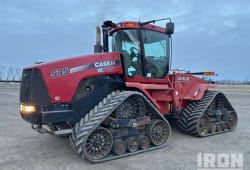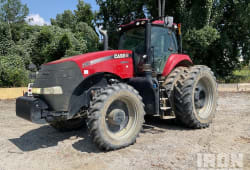Precision Farming Revealed: Smart Agriculture Equipment Leading the Way
9 Min read
)
January 18, 2024
Precision farming, also known as precision agriculture, is revolutionizing the agricultural landscape. This approach leverages smart agriculture equipment and advanced technologies to optimize various farming processes. From planting to harvesting, farmers are embracing precision farming to increase efficiency, reduce resource usage, and maximize yields. Precision farming has emerged as a game-changer in modern agriculture, harnessing the power of cutting-edge technologies to revolutionize traditional farming practices. Precision farming, also known as precision agriculture, is a farming management concept that utilizes technology to optimize various aspects of the farming process. At its core, precision farming relies on data-driven insights to make informed decisions about crop management. Key principles include:
The Explanation of Smart Agriculture equipments
Smart agriculture equipment refers to the integration of advanced technologies and digital solutions into traditional farming practices to enhance efficiency, productivity, and sustainability in agriculture. These technologies leverage data, sensors, connectivity, and automation to optimize various aspects of crop cultivation and livestock management. The goal of smart agriculture is to make farming more precise, resource-efficient, and environmentally sustainable.
Key components of these hi-tech equipment include:
1. Sensors: These devices are deployed in the field to collect data on various parameters such as soil moisture, temperature, humidity, and crop health. The data collected from sensors provide valuable insights into the condition of crops and soil, enabling farmers to make informed decisions.
2. IoT (Internet of Things): Smart agriculture relies on interconnected devices and systems through the Internet of Things. This connectivity allows farmers to remotely monitor and control equipment, receive real-time data, and make adjustments based on the information collected.
3. Automation: Automation technologies such as robotics and drones play a crucial role in smart agriculture. Drones can be used for aerial monitoring, crop spraying, and mapping, while robotic systems can handle tasks like planting, weeding, and harvesting. Automation reduces the need for manual labor and improves efficiency.
4. Data Analytics: The vast amount of data generated by sensors and devices is analyzed using advanced analytics tools. Farmers can gain insights into crop performance, identify potential issues, and optimize resource usage. Predictive analytics also enable better decision-making by forecasting weather patterns, disease outbreaks, and crop yields.
5. Precision Farming: This involves the precise management of resources, such as water, fertilizers, and pesticides, based on the specific needs of different areas within a field. GPS technology and mapping tools are often used to create detailed field maps and guide equipment to operate with accuracy.
6. Remote Monitoring and Control: Farmers can monitor and control their agricultural operations remotely using mobile apps or web-based platforms. This allows them to respond promptly to changing conditions and manage their farms efficiently.
7. Climate and Weather Forecasting: Integration of weather data into smart agriculture systems helps farmers anticipate weather changes and plan their activities accordingly. This information is crucial for making decisions related to planting, harvesting, and irrigation.
8. Machine Learning and Artificial Intelligence: These technologies are applied to analyze historical data, identify patterns, and make predictions. Machine learning algorithms can assist in crop disease detection, yield prediction, and other decision-making processes.
Smart agriculture equipment contributes to sustainable farming practices by optimizing resource usage, minimizing environmental impact, and improving overall productivity. By adopting these technologies, farmers can enhance their decision-making capabilities and contribute to the development of a more resilient and efficient agricultural sector.
Evolution of Agriculture Technology
The journey of precision farming can be traced back to the evolution of agricultural equipment technology. As traditional methods gave way to mechanization, the groundwork for precision farming was laid with the introduction of:
Tractor Technology: The integration of tractors into farming practices marked the beginning of mechanization, enabling farmers to cover larger areas efficiently.
GPS Technology: The advent of GPS technology allowed for accurate mapping and navigation, setting the stage for precision in planting and field operations.
Sensor Innovations: The development of advanced sensors facilitated real-time monitoring of soil and crop conditions, providing valuable insights for decision-making.
Accurate Data Collection: Utilizing sensors, satellites, and other technologies to collect precise data about soil conditions, weather patterns, and crop health.
Targeted Application: Applying inputs such as seeds, fertilizers, and pesticides with precision, ensuring optimal use and minimizing waste.
Advanced Machinery Integration: Incorporating smart equipment with GPS and automation features for precise planting, cultivation, and harvesting
Advantages to farmers by adopting smart agriculture equipment
In recent years, the agricultural landscape has undergone a revolutionary transformation with the integration of smart agriculture equipment. These cutting-edge technologies leverage the power of data, connectivity, and automation to enhance the efficiency, productivity, and sustainability of farming practices. As farmers embrace these innovations, they not only streamline their operations but also contribute to the evolution of a more resilient and productive agricultural sector. In this blog post, we will explore the myriad advantages that farmers can gain by adopting smart agriculture equipment.
1. Precision Farming
One of the key benefits of smart agriculture equipment is precision farming, a practice that involves using technology to optimize various aspects of crop production. GPS-guided tractors, drones, and sensors enable farmers to precisely manage resources such as water, fertilizers, and pesticides. This targeted approach not only minimizes waste but also improves crop yields, leading to increased profitability for farmers.
2. Improved Resource Management
Smart equipment facilitates real-time monitoring and management of resources, allowing farmers to make data-driven decisions. Sensors embedded in the soil can provide valuable information about moisture levels, nutrient content, and temperature. This data helps farmers optimize irrigation schedules, apply fertilizers more efficiently, and mitigate the impact of adverse weather conditions, ultimately enhancing resource management.
3. Automation for Increased Efficiency
The introduction of automation in agriculture has revolutionized traditional farming practices. Smart tractors, harvesters, and other autonomous machinery can perform tasks with a level of precision and efficiency unmatched by manual labor. This not only reduces the physical strain on farmers but also allows them to focus on more strategic aspects of farm management, leading to increased overall efficiency.
4. Data-Driven Decision-Making
Smart agriculture equipment generates a vast amount of data through sensors, GPS technology, and other monitoring devices. This data can be analyzed to gain valuable insights into crop health, weather patterns, and overall farm performance. Farmers can use this information to make informed decisions about planting, harvesting, and resource allocation, resulting in better yields and economic gains.
5. Remote Monitoring and Control
With the advent of the Internet of Things (IoT), farmers can remotely monitor and control various aspects of their operations. Connected devices and sensors enable real-time surveillance of crops, livestock, and equipment. This remote accessibility allows farmers to respond promptly to emerging issues, reducing the risk of crop diseases, pest infestations, and equipment malfunctions.
6. Enhanced Crop Quality
Smart agriculture equipment contributes to improved crop quality through precise control over cultivation conditions. Monitoring and adjusting factors such as soil composition, irrigation, and temperature ensure optimal growing conditions. As a result, farmers can produce crops with consistent quality, meeting the stringent requirements of modern markets and demanding consumers.
7. Sustainable Agriculture Practices
The adoption of smart agriculture equipment aligns with the growing emphasis on sustainability in the agricultural sector. Precision farming reduces the environmental impact of farming activities by minimizing the use of water, fertilizers, and pesticides. Sustainable practices not only benefit the environment but also position farmers as stewards of natural resources, enhancing their reputation in the eyes of consumers and regulatory bodies.
8. Cost Savings
While the initial investment in this equipment may seem substantial, the long-term benefits often outweigh the costs. Precision farming and automation lead to significant cost savings by optimizing resource use, reducing labor expenses, and minimizing waste. Over time, farmers can realize a substantial return on investment, making smart agriculture a financially viable option.
9. Increased Connectivity
Smart agriculture promotes connectivity among various stakeholders in the agricultural value chain. Farmers can share data with suppliers, agronomists, and researchers, fostering collaboration and knowledge exchange. This interconnectedness not only enhances the efficiency of agricultural operations but also contributes to the development of innovative solutions and practices.
10. Risk Mitigation
Smart agriculture equipment provides farmers with tools to proactively manage risks associated with unpredictable factors such as weather events, diseases, and market fluctuations. By leveraging real-time data and predictive analytics, farmers can implement preventive measures, optimize planting schedules, and adjust production strategies to minimize the impact of adverse conditions, thus enhancing overall resilience.
Final thoughts
In conclusion, the adoption of smart agriculture equipment heralds a new era of possibilities for farmers. The integration of precision farming, automation, data-driven decision-making, and sustainable practices empowers farmers to overcome challenges and thrive in an ever-evolving agricultural landscape. As the benefits of smart agriculture become increasingly evident, it is clear that embracing these technologies is not just a choice but a necessity for farmers seeking to secure a more efficient, productive, and sustainable future for global agriculture. The integration of precision farming, automation, data-driven decision-making, and sustainable practices empowers farmers to overcome challenges and thrive in an ever-evolving agricultural landscape. As the benefits of smart agriculture become increasingly evident, it is clear that embracing these technologies is not just a choice but a necessity for farmers seeking to secure a more efficient, productive, and sustainable future for global agriculture.















